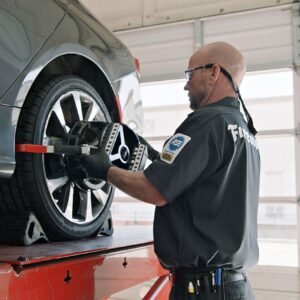If you’ve noticed the tire pressure light glowing on your dashboard, it’s important not to ignore it. While it often means that one or more of your tires have low pressure, it could also indicate a sensor issue. Knowing how to reset the tire pressure light properly is crucial for ensuring that your car’s safety systems function correctly. In this article, we will walk you through the steps on how to reset tire pressure light, and explain the key steps to perform a dashboard warning reset.
This article is from the team at Watancar Motors Store, dedicated to providing the best advice and information on car maintenance and fixing issues like tire pressure light
What is the Tire Pressure Light?
The tire pressure light, also known as the TPMS (Tire Pressure Monitoring System) light, is a dashboard indicator that warns you when one or more of your tires have low air pressure. Proper tire pressure is essential for vehicle safety, fuel efficiency, and tire longevity. A malfunctioning TPMS or a tire pressure issue can affect your car’s performance, so it’s important to address the light immediately.
Why Does the Tire Pressure Light Turn On?
There are several reasons why the tire pressure light may illuminate on your dashboard:
- Low Tire Pressure: The most common reason is that one or more tires have lost air. This can be caused by temperature changes, punctures, or natural air leakage.
- Sensor Malfunction: Sometimes, the issue may be with the TPMS sensors themselves, especially if the light stays on after inflating your tires.
- Tire Wear: Worn-out tires may also affect the system, causing the light to turn on even if the air pressure is adequate.
- After Tire Rotation: If you’ve recently rotated your tires, the system may need to be reset.
Steps on How to Reset Tire Pressure Light
Once you’ve addressed the underlying issue (low tire pressure, puncture repair, etc.), you may need to reset the tire pressure light. Here’s a simple guide to help you through the process:
1. Check Tire Pressure
Before resetting the light, ensure all your tires are properly inflated. Use a tire pressure gauge to check each tire and inflate them to the recommended PSI (pounds per square inch) as indicated in your vehicle’s owner manual or the label inside the driver’s side door.
2. Turn the Ignition to the “ON” Position
Turn your car’s ignition to the “ON” position, but don’t start the engine. This is necessary for the reset process. Some vehicles require you to press the “Start” button once without pressing the brake pedal if your car uses a push-to-start system.
3. Locate the Tire Pressure Reset Button
Most vehicles have a tire pressure warning reset button located underneath the steering wheel, on the dashboard, or near the fuse box. Refer to your owner’s manual to locate it. Press and hold the reset button for about 3-5 seconds until the tire pressure light blinks and then goes off.
4. Start the Car and Check
After the light goes off, start your engine and drive around for a few minutes. The light should remain off if the reset was successful. If it comes back on, you may need to repeat the process or check for a tire issue or sensor malfunction.
What If the Tire Pressure Light Doesn’t Reset?
If you’ve followed the steps on how to reset tire pressure light but the light remains on, there could be a deeper issue. Here are a few possible reasons why it might not reset:
- Faulty TPMS Sensors: If the sensors are damaged or malfunctioning, the system will fail to reset. In this case, you may need to replace the sensors.
- Uneven Tire Pressure: Double-check the tire pressure with a gauge to ensure each tire is properly inflated to the recommended PSI.
- Sensor Calibration: Sometimes, after a tire change or rotation, the sensors may require recalibration. Some vehicles need a specific procedure to calibrate the sensors.
- Wiring Issues: In rare cases, damaged wiring or electrical issues could cause the system to malfunction, preventing the reset.

Dashboard Warning Reset: When to Seek Professional Help
If you’ve tried a dashboard warning reset and the tire pressure light continues to appear, it might be time to seek professional help. A certified mechanic can run a diagnostic check on your vehicle’s TPMS system to identify and resolve any sensor malfunctions or wiring issues.
Additionally, if you notice the light comes on repeatedly after resetting, or if there are any other warning lights on your dashboard, it’s a good idea to have your vehicle inspected by a professional to ensure your car’s safety systems are functioning correctly.
Conclusion
Knowing how to reset tire pressure light can save you time and hassle when it comes to maintaining your car. It’s crucial to address low tire pressure as soon as possible to avoid driving hazards. Always check your tire pressure before resetting the light, and ensure that all your tires are in optimal condition. If the warning light persists after the reset, don’t hesitate to consult a professional for further diagnostics.
Properly maintaining your tires is not only key to your safety but also to improving fuel efficiency and extending the life of your tires. A dashboard warning reset is a simple process that keeps your vehicle in top shape, so make sure to reset the light whenever necessary!
Discover the best engine oil types explained for your car’s performance





